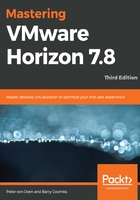
High-level architectural overview
In this section, we are going to discuss the core Horizon View features and functionality for brokering virtual desktop machines that are hosted on the VMware vSphere platform.
The Horizon architecture is straightforward to understand, as its foundations lie in the standard VMware vSphere products (ESXi and vCenter). So, if you have the skills and experience of working with this platform, then you are already halfway there.
Horizon View builds on the vSphere infrastructure, taking advantage of some of the features of the ESXi hypervisor and vCenter Server, adding a number of virtual server machines to perform the various View roles and functions.
An overview of the View architecture for delivering virtual desktops is shown in the following diagram:

Horizon View infrastructure components run as applications that are installed on the Microsoft Windows Server operating system, except for the Unified Access Gateway, which is a hardened Linux-based appliance. In theory, these infrastructure components could run on physical machines; however, there are a great number of benefits when you run them as virtual machines, such as delivering HA and DR, as well as the typical cost savings that can be achieved through virtualization.
The following sections will cover each of these roles and components of the View architecture in greater detail, starting with the Horizon View Connection Server.